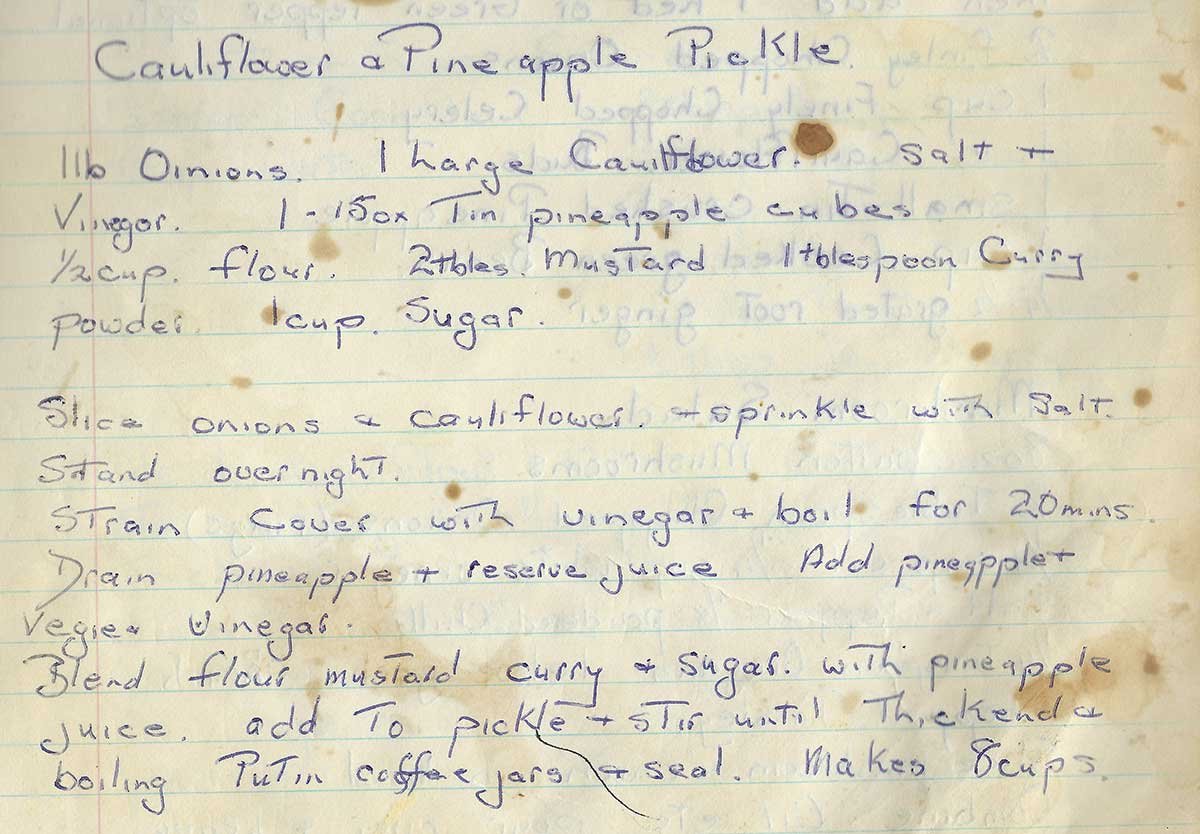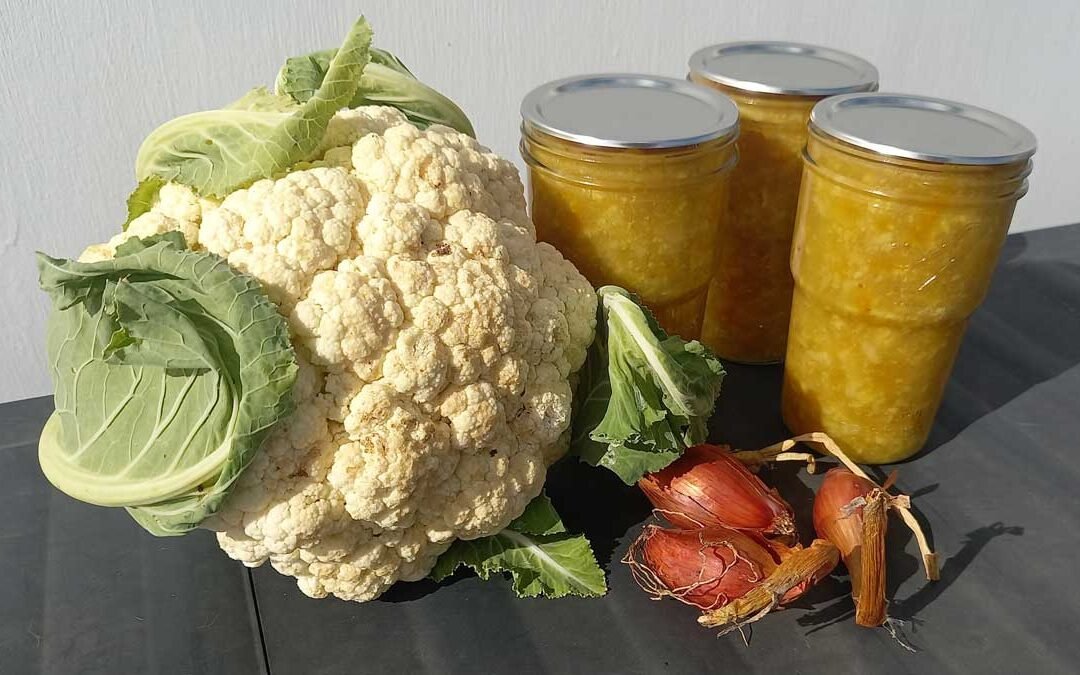I’ve been slowly making my way through my grandmother’s handwritten recipe book for a couple of years now.
I’m testing and refining recipes. The originals are frequently missing instructions, measurements, cooking times, and temperatures. Some recipes are in metric while others are in imperial. Once in a while, the ingredients don’t even exist anymore!
Slowly, I’m compiling the original book into recipes that are delicious; in metric measurements; using ingredients that are possible to source. I’ve been sharing them here on my website and directly with my family as I go.
Some other recipes I’ve found in the book and gone on to refine include Gran Shirley’s Sally Lunn; Sponge-Top Pudding; my great grandmother’s Christmas Cake; and Coconut Slice. Wherever possible, I try to use ingredients that I grew. It’s part of the fun.
One recipe I’ve been trying to get to for a while is Cauliflower and Pineapple Pickle. Last year, cauliflowers were upwards of $6 each and my attempt at growing them ended in a gooey mess.
But this season, I have succeeded in growing half a dozen decent cauliflowers, and it’s time to give the pickle a whirl.
Recipe refinement
Here’s a scan of Gran’s original recipe, in case you’re interested.

As you can see, it lacks some certainty in the ingredients – how much salt? What kind of vinegar? I also noted that with a couple of changes and substitutions, I could make a pickle that I substantially grew.
Aside from the cauliflower, I could sub out the onions for last season’s shallots. One day I might be able to use home-grown pineapple too, but my plants still haven’t produced them, so I’m sticking to a can for now.
In terms of the spices, I have always hated curry powder. I don’t feel bad about that because as I’ve grown older I’ve learned that it’s mostly a colonialized bastard of a spice anyway. But I decided to take a look at the constituents and see if the problem stood out.

While I would need to use purchased cumin; I have grown coriander seed, turmeric, garlic, and ginger. I’m pretty sure fennel and fenugreek are my problems so I decided to skip them. I didn’t see the point of adding more salt so I skipped that too.
Finally, Gran’s version of the recipe wasn’t gluten-free, and I didn’t see any reason a pickle needed to contain gluten. It’s not a concern for me personally, but I often give things like this away. Enough people don’t eat gluten that when it’s not actually necessary, I look to substitute.
In this case, I swapped the plain flour for gluten-free cornflour as a thickener. I could go about making my own arrowroot flour to use here if I really wanted to stretch the ‘homegrown ingredient’ angle, but it’s not on-hand so for simplicity’s sake, I’m not going to bother with it this round.
Chopping, brining, and figuring it out
It took me over an hour to chop the entire cauliflower and all the shallots. I went for quite small florets of cauliflower and my shallots were closer to diced than sliced. The chooks were happy to demolish all the stems and slugs I discarded along the way.
The chopped veggies went into a big glass bowl, layered with salt, to brine overnight. I used 5 teaspoons of salt.
The next day, I drained the veggies, then put them in a pot. The recipe directed me to “cover with vinegar” but didn’t direct me on what kind of vinegar, or how much that would be.
Some research led me to believe that the kind of vinegar is mostly up to me. Perhaps Gran just used whatever she had on hand. My kitchen is stocked with cider vinegar, malt vinegar, white vinegar, rice wine vinegar, and balsamic vinegar. I have choices.
I decided to go with a mix of cider vinegar, white vinegar, and malt vinegar. Covering the veggies took 1.5 litres – or 6 cups of vinegar; but I guess it would somewhat depend on how large your cauliflower is.
Ingredients
Here’s how the final recipe stacked up after all my changes.
450 grams shallots – peeled and chopped
1 large cauliflower
5 teaspoons salt
1.5 litres (6 cups) vinegar (wine, cider, white, malt; in whatever ratio you choose)
1 can pineapple in juice
2cm fresh turmeric – finely grated
1cm fresh ginger – finely grated
2 cloves garlic – finely chopped
½ cup gluten free cornflour
2 Tablespoons Coleman’s mustard powder*
½ Tablespoon cumin
½ Tablespoon coriander
1 cup sugar
Method
- Slice onions and cauliflower. Sprinkle with salt and leave in a bowl covered with a tea towel to stand overnight.
- Strain vegetables. Place in pot, cover with vinegar, and boil for 20 minutes. Keep on the heat.
- Drain pineapple and reserve juice. Add pineapple to the pot.
- Mix cornflour, mustard*, turmeric, ginger, garlic, cumin, coriander, and sugar with pineapple juice.
- Add cornflour slurry to pickling vegetables and stir until thickened and boiling.
- Remove from heat. Put into sterilized jars and seal. Wait 3 weeks before eating.
* I know I should wait at least 3 weeks to allow all the flavours to develop, but on initial tasting, I wish I’d used about half the amount of mustard.
Canning
I decided to can these properly and put them into Kate’s Kitchen 450ml Stackable Preserving Jars. The recipe filled 6 of them.
After filling, I wiped off any drips from the edge of the jar and placed on my lids. Then I processed them in a stock pot of boiling water for 20 minutes.
Now they’re sitting in a cupboard of preserves. It’s not quite my Gran’s cupboard of preserves (that was epic), but slowly, it is being stocked with her recipes. And I think that’s pretty cool.



This recipe is very similar to my nana’s Cauli pickle. Everything is the same minus the pineapple. But instead it has more sugar. We use malt vinegar. It’s a family favorite
I came across a few similar recipes when I did my research – how cool your Nana has one too! Any favourite ways to use it? I’m thinking it’d be great on a ham sandwich.